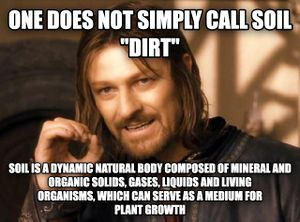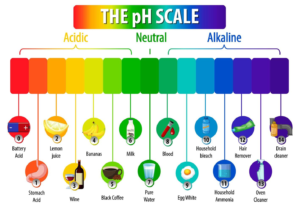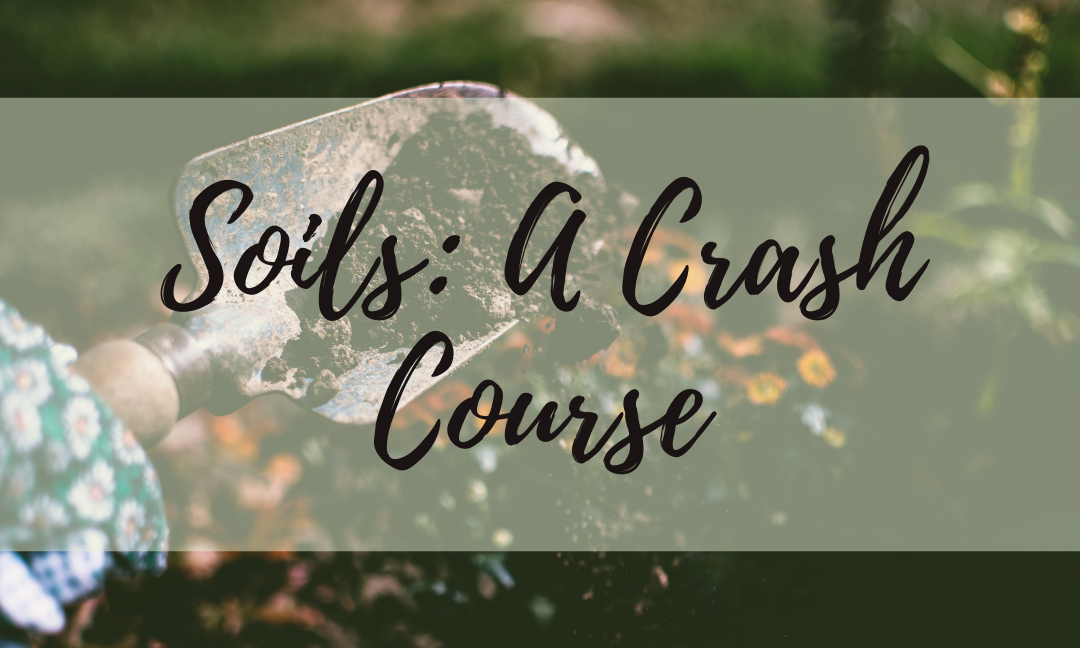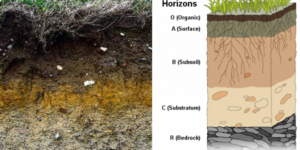Written by: Christina Pizzonia
Soil—we’ve all seen it, heard about it and, at the very least, stepped on it. But what is soil actually? (hint: it’s not just ‘that brown stuff in the ground’). How can gardeners improve the quality of their soil? Continue reading to find out!
Where does soil come from?
Contrary to popular belief, the soils we know (and love) weren’t always here. In fact, while the Earth is ~4.5 billion years old, the reddish-brown soils common today only emerged around 400 million years ago!
The formation of soil started with bedrock (basically – different kinds of rocks, like igneous, metamorphic or sedimentary). Over time, bedrock was broken down into smaller and smaller pieces through physical and chemical means in a process known as “weathering.” The result? What we now recognize as soil!
Different factors, including the climate, timespan, topography and overall biodiversity can influence the kind of soil produced from a given type of bedrock. In fact, scientists can actually use these factors to predict the kinds of soils that will be present in your neighbourhood in the future!
The horizons
Once well-formed, most soils can be split into different “horizons” or “horizontal layers.” These are illustrated in the soil profile below:
The top-most layer is known as the O horizon, and is found in most soils. It’s composed mainly of organic materials, including leaves, twigs, leaves, mosses, etc.
The next layer is known as the A horizon (surface/topsoil), and is composed predominantly of minerals (from bedrock). The A horizon may also contain some organic matter from the O horizon.
The following layer is the B horizon (subsoil), and contains the accumulation of minerals from the upper horizons.
The C horizon (substratum) sits just beneath the B horizon, and is composed mainly of broken down rocks (“parent material” to scientists).
The bottom-most horizon is the R horizon, or bedrock. This layer is made up of the original rocks from which the parent material was made.
The four major ingredients
 The first (and most well-known) ingredient of soil is organic matter, making up only ~5% of soil by volume. Organic matter (i.e. material derived from decaying plant, animal and microbial residue) is generally darker in colour, and is an excellent source of essential nutrients. Microorganisms thrive in organic matter, converting it into substances that can be easily uptaken by plants. Perhaps the most famous interaction between microorganisms and organic matter in soil involves the nitrogen cycle—microorganisms “fix” the nitrogen in organic matter, transforming it into a form that can be used by plants! Fun fact: A teaspoon of healthy soil actually contains more organisms than there are people on earth!
The first (and most well-known) ingredient of soil is organic matter, making up only ~5% of soil by volume. Organic matter (i.e. material derived from decaying plant, animal and microbial residue) is generally darker in colour, and is an excellent source of essential nutrients. Microorganisms thrive in organic matter, converting it into substances that can be easily uptaken by plants. Perhaps the most famous interaction between microorganisms and organic matter in soil involves the nitrogen cycle—microorganisms “fix” the nitrogen in organic matter, transforming it into a form that can be used by plants! Fun fact: A teaspoon of healthy soil actually contains more organisms than there are people on earth!
Water and air (both make up around 25% of soil each) are another two ingredients. Water is found in the pore space of soil, and acts as a transporter for essential nutrients (plants uptake most nutrients from soil using a water-based transport system). Air is also critical, as it provides oxygen (air is ~20% oxygen) to organisms living within the soil.
And, of course, last but not least, minerals. Soil minerals make up the bulk of soils (~45% by volume), are divided into different main classes based on the size of their particles. Clay particles are the smallest (< 0.002 mm), followed by silt (0.05 – 0.002 mm), then sand (2 – 0.05 mm). Different types of soil contain different ratios of these three types of particles.
If you want to find out the approximate percentages of each particle type (sand, silt or clay) that makes up your garden, you can! Check out this video to find out how (it’s super simple, I promise!). Now, if you’re dissatisfied with the results, and want to change the composition of your soil to better suit your gardening needs, that’s possible too—and you wouldn’t be alone in that goal. Sandy soils contain a lot of pore/open space and can barely hold water—while silty and clay-based soils (due to their smaller particle sizes) are easily compacted and can restrict water/nutrient uptake by plant roots. The solution to both problems is to add organic matter. Adding organic matter to clay/silty soil can improve infiltration and pore space (i.e. spots for air/water to reside), while adding organic matter to sandy soil can drastically increase the water-holding capacity of the soil. That’s what I call a win-win.
Other Classifications
In addition to being classified based on their particle type (sand, silt or clay), soils may also be classified based on their relative acidity. Chemists measure the acidity of a substance using something called the pH scale, which typically ranges from 1 to 14.

Substances with a higher ratio of hydronium (positive) to hydroxide (negative) ions are said to be acidic, with a pH ranging from 0 to ~6.5, while substances with a high ratio of hydroxide (negative) to hydronium (positive) ions are said to be alkaline, with a pH ranging from ~7.5 to 14. Substances with an equal ratio of both ions are said to be neutral, with a pH of ~7.
To test the pH of your soil, you can purchase pH paper from your local hardware store. Most plants grow best in slightly acidic soil, with a pH of about 6.5 to 6.8, through depending on what you’re growing, a healthy range can be anywhere from 6.0 (e.g. potatoes, strawberries, blueberries, etc.) to 7.5 (e.g. cauliflower, cabbage, etc.). If the pH of your soil is significantly higher or lower, plant roots may have a difficult time absorbing essential nutrients— while concentrations of certain metals (e.g. iron, aluminum, manganese, etc.) increase. Although trace amounts of metals are a necessary component of any soil, high concentrations can have an adverse effect on plant growth.
Safely improving the pH of soil takes time (think: at least a few months), but it can be done. If your soil is too acidic (pH < 6.0), it may be due to high levels of precipitation or a sudden influx of organic matter (pine needles, peat moss, oak leaves, etc.). To increase your soil’s pH, you can add liming materials (dolomitic limestone, wood ash) or calcium hydroxides.
If your soil is too basic (pH > 7.5), it may be due to the addition of nitrogen fertilizers or simply from the parent material itself. The addition of elemental sulfur can rectify this imbalance.
Closing Thoughts
As we’ve seen above, soil is super complex – and is composed of many different parts all working in harmony. Like it or not, soil is essential for life. It can even:
- Eliminate potential pollutants—microbes in soil can degrade and immobilize certain kinds of industrial and municipal byproducts
- Cycle nutrients—essential nutrients such as carbon, nitrogen and phosphorus are stored and transformed by the microorganisms in soil
- Provide support—the composition of soil is ideal for plant growth and for the construction of human structures
Unfortunately, most soils today are under threat by unsustainable agricultural practices (deforestation, overgrazing, over-tilling, soil compaction, etc.) and industrial activities (illegal dumping, accidental contamination, etc).
If you want to get involved with soil conservation, or learn more about how soils work and why they’re vital parts of our ecosystem, feel free to check out these resources:
- Forest Ontario’s Soils Guide
- Nature’s Introduction to Soils
- All About Soils: Soil Science Society of America
- Soil Conservation Council of Canada Website
But yeah—that’s soils! Hope you enjoyed learning a bit about a massively underrated part of our planet! Thanks for reading!
Sources:
https://www.trugreen.com/lawn-care-101/learning-center/grass-basics/dig-deeper/soil-texture
https://transform.iema.net/article/supporting-our-soils
https://www.gardeners.com/how-to/building-healthy-soil/5060.html
https://www.nrcs.usda.gov/wps/portal/nrcs/main/soils/health/
https://forestsontario.ca/en/resource/soil



